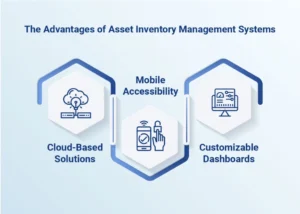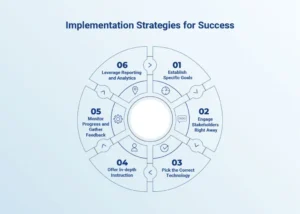Asset Inventory Management Systems: Making Asset Tracking Easy
2024-11-14
How easily could you demonstrate a list of your company’s assets if you were asked to do so? Companies with a large number of assets can only provide it if they have an effective inventory management system in place. From manufacturing and retail to healthcare and technology, companies in many different fields are realizing the need for Asset Inventory Management Systems as fundamental tools for tracking and controlling their assets.
In this blog, we will look at what inventory asset management systems are, their benefits, key features, and how they reduce the complexities of asset tracking.
Understanding Asset Inventory Management Systems
Asset Inventory Management Systems are software programs meant to enable companies to monitor and control their tangible assets all through their lifetime. These assets could range from office supplies and technology tools to machinery and equipment. Organizations can use systems asset management to monitor asset location, condition, utilization, and regulatory compliance.
Challenges of Traditional Asset Tracking
Manual Processes
Manual entry of asset data can lead to inaccuracies. Typos, mislabeling, or oversight can result in lost or misplaced assets, leading to financial losses and inefficiencies.
Lack of Visibility
Traditional methods often lack real-time visibility into asset status and location. This can hinder decision-making and lead to underutilization or overstocking of assets.
Inconsistent Data
Different teams may use various tracking methods, leading to inconsistent data across the organization. This lack of standardization can create confusion and complicate reporting.
The Advantages and Benefits of Asset Inventory Management Systems

Cloud-Based Solutions with IT Asset Management System
Real-time data from any place made possible by cloud-based asset inventory management solutions helps teams to work smoothly. By means of consistent upgrades and backups, they improve data security, therefore lessening the demand for large IT infrastructure and associated expenses. This adaptability lets companies grow their asset management as required.
Mobile Accessibility with Asset and Inventory Management System
Mobile accessibility is yet one of the important benefits of asset management systems. It improves responsiveness and efficiency by letting users manage assets anywhere, anytime. Real-time inventory updating, issue reporting, and direct audit conduct from field staff devices allow them to This capacity guarantees quick decision-making and enhanced communication, which eventually helps to control resources and lower downtime by means of smarter decisions.
Customizable Dashboards with Asset Tracking System
Customisable dashboards let users fit their interface to show pertinent KPIs and analytics, therefore enabling quick asset performance insights. This personalisation improves user involvement and productivity, therefore freeing teams to concentrate on important facts supporting decision-making. Visual analytics let stakeholders quickly spot trends and make educated corrections.
Implementation Strategies for Success

Establish Specific Goals
Before implementation, identify the specific goals you want to achieve with the asset management system. Are you looking to reduce losses, improve efficiency, or enhance reporting capabilities? Clearly defined objectives will guide the selection of the right system and help measure success post implementation.
Engage Stakeholders Right Away
Engage key stakeholders from various departments, including IT, finance, and operations, during the planning phase. Their insights can help identify unique needs and challenges, ensuring the system is tailored to serve the entire organization effectively. Early involvement fosters buy-in and eases resistance to change.
Pick the Correct Technology
Select an asset inventory management system that aligns with your organization’s needs. Consider features such as cloud-based solutions, mobile accessibility, and customizable dashboards. Evaluate different vendors, request demos, and gather feedback from end-users to ensure the chosen system enhances efficiency and usability.
Offer In-depth Instruction
Proper training is essential for user adoption. Develop a comprehensive training program that includes hands-on sessions, user manuals, and ongoing support. Tailor training to different user levels and roles, ensuring everyone understands how to navigate the system and utilise its features effectively.
Monitor Progress and Gather Feedback
After implementation, continuously monitor the system’s performance against your initial objectives. Solicit feedback from users to identify any challenges they face or areas for improvement. Regular check-ins can help address issues promptly and ensure the system evolves with the organization’s needs.
Leverage Reporting and Analytics
Utilize the reporting and analytics features of the asset management system to gain insights into asset performance and utilization. Regularly review reports to identify trends, track KPIs, and make informed decisions about resource allocation, maintenance schedules, and future investments.
How AntMyERP Systems Might be Best Suited for Different Types of Businesses
Using AntMyERP systems is a terrific way for businesses of any size to streamline their operations. AntMyERP provides a flexible, reasonably priced solution combining accounting, inventory, sales, and customer administration onto one platform for startups and small businesses. This maintains low expenses and helps companies remain orderly and effective.
AntMyERP is good for mid-sized businesses because it can grow with them because it has more advanced tools like supply chain management, HR systems, and detailed reporting. The system improves cooperation by smoothly integrating several departments and offers insightful analysis for decision-making.
AntMyERP provides large businesses with choices for customization, multi-location management, and handling of difficult processes. Its cloud-based system guarantees real-time updates over worldwide operations and safe data access.
All things considered, AntMyERP is a flexible solution that can be customized to fit companies at all phases, therefore enabling resource optimization and long-term success.
Conclusion
For companies trying to simplify their asset tracking procedures, AntMyERP’s asset inventory management systems are quite helpful tools. Businesses can increase productivity, lower expenses, and improve decision-making by using features including cloud-based solutions, mobile accessibility and customizable dashboards.
Investing in a strong inventory management system is not only helpful but also necessary for success as asset management gets ever more complicated. Adopting these technologies will result in a more orderly, effective, and efficient workplace, therefore promoting company success and expansion.
AntMyERP also helps with services such as AMC management, Warranty management, After-sales Service Management, Return Material Authorization, etc.

